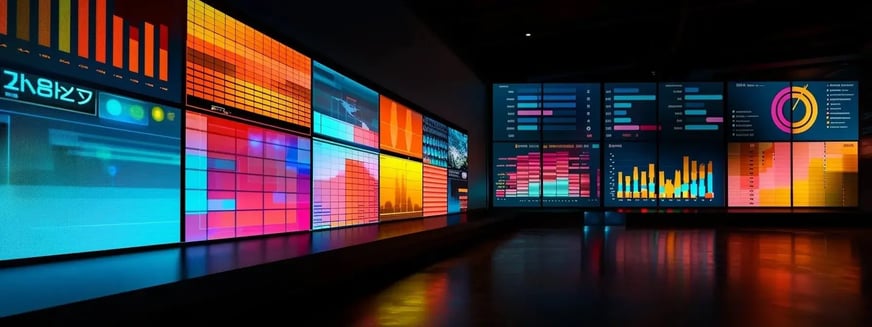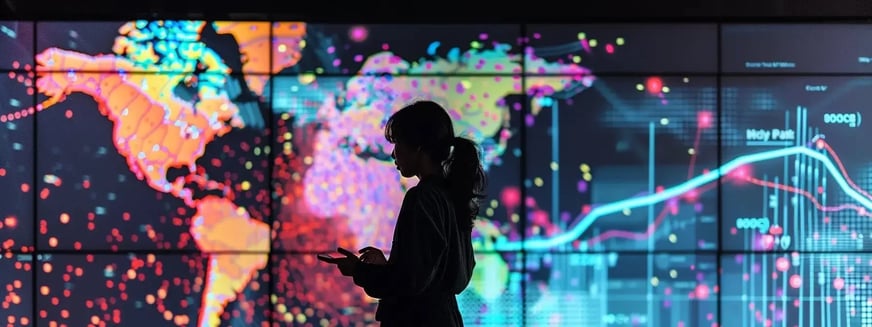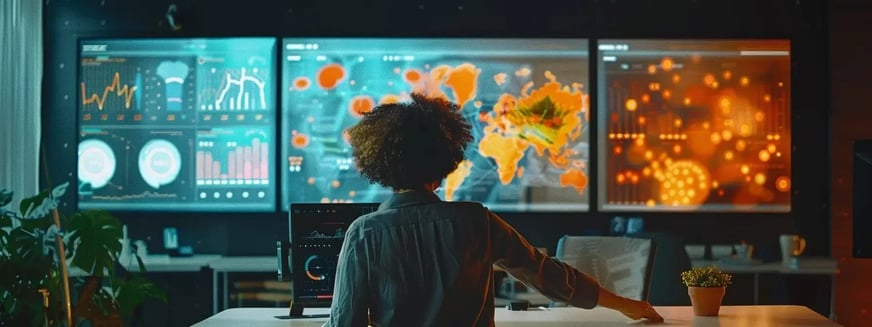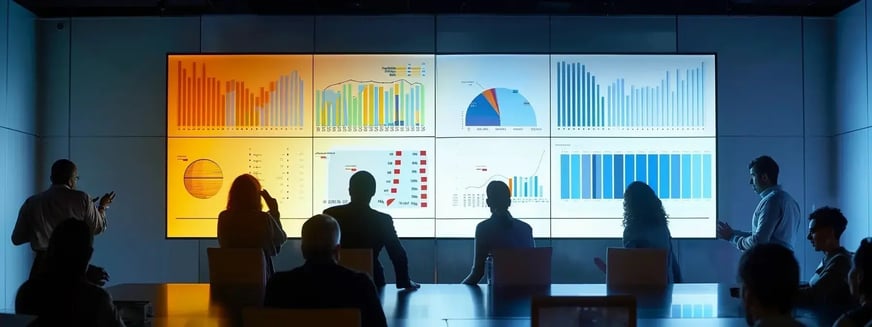Master Data Visualization Techniques - Unlock Your BA Potential
Data visualizations can reveal important insights, yet many struggle to create effective representations of information. This blog post, "Mastering Data Visualization Techniques to Unlock Your Potential," will explore the fundamentals of data visualization, essential tools, and advanced techniques. Readers will learn how to craft compelling narratives from their data, identify outliers, and mitigate bias to improve decision-making. This content aims to help individuals unlock greater personal and professional growth in their data management efforts by addressing common pain points associated with data mining and representation.
Key Takeaways
- Data visualization simplifies complex data, supporting effective analysis and decision-making.
- Selecting appropriate visualization types enhances clarity, revealing insights from various data sets
- Tools like Tableau and Matplotlib facilitate dynamic visualizations and predictive analytics.
- Maintaining accuracy and inclusivity is vital to ensure effective data representation for diverse audiences.
- Continuing education in data visualization techniques keeps professionals competitive and adept with industry trends
Understanding the Fundamentals of Data Visualization

Data visualization transforms complex analytics into comprehensible visuals, playing a vital role in modern decision-making. Understanding its key concepts is essential for effective data analysis. Additionally, various types of data visualizations serve specific purposes, offering insights into patterns and trends. Effective data visualization impacts business insights significantly, enabling data science professionals to make informed decisions and drive exploration in their respective fields.
Defining Data Visualization and Its Key Concepts
Data visualization is the process of converting raw data sets into visual formats that facilitate understanding and analysis. Key concepts include the use of animation to depict changes over time, as well as infographics that consolidate complex information in an accessible manner. These techniques support exploratory data analysis, allowing professionals to identify trends and patterns effectively while considering critical intervals that influence data interpretation.
The Role of Data Visualization in Modern Decision-Making
Data visualization plays a critical role in modern decision-making by transforming big data into clear graphics that enhance understanding and analysis. Effective tools like Matplotlib help visualize complex data sets, allowing stakeholders to focus their attention on essential information that drives intelligent decisions. By presenting data visually, organizations can quickly identify trends and outliers, making it easier to respond to evolving market conditions and user needs.
- Importance of clear representation of complex data
- Tools like Matplotlib for effective visualization
- Quick identification of trends through graphics
- Data-driven intelligence for informed decision-making
- Responsive strategies based on visual insights
Common Types of Data Visualizations and When to Use Them
Understanding the common types of data visualizations is essential for effective analysis of raw data in any research initiative. Pie charts are ideal for displaying the composition of a dataset, showcasing how individual parts contribute to the whole, while scatter plots are useful for illustrating relationships and patterns between two variables. Selecting the appropriate type of data visualization not only enhances clarity but also empowers decision-makers to derive actionable insights from their data visualization data:
| Visualization Type | Best Used For |
|---|---|
| Pie Chart | Comparing parts of a whole |
| Scatter Plot | Showing relationships between two variables |
| Bar Chart | Comparing discrete categories |
| Line Graph | Tracking changes over time |
| Heat Map | Displaying data density and variances |
The Impact of Effective Data Visualization on Business Insights
Effective data visualization significantly enhances business intelligence by presenting complex data in accessible formats, which leads to more informed decision-making. For instance, a bar chart can highlight customer experience metrics, enabling experts to quickly identify areas for improvement. As companies increasingly rely on cloud computing for data storage and retrieval, the ability to visualize insights in real-time becomes essential, fostering a proactive approach to responding to market demands and customer needs.
Essential Tools and Software for Data Visualization Mastery

This section will provide an overview of popular data visualization platforms, outlining their features and capabilities. Readers will learn the criteria for selecting the appropriate tool based on their analysis needs and existing systems. Furthermore, the discussion will include an evaluation of free versus paid tools, helping users to assess their options effectively, particularly in the context of regression analysis and identifying market trends. Insights on integrating tools for enhanced interactivity will also be addressed.
Overview of Popular Data Visualization Platforms
When exploring data visualization platforms, professionals often find that tools like Tableau Desktop stand out for their versatility and user-friendly interface. These platforms interact seamlessly with various databases, enabling users to manipulate parameters easily and perform complex analyses, including predictive analytics. Mastering such tools not only hones one’s skill in data visualization but also equips professionals to drive better decision-making and insight extraction from their data.
- Tableau Desktop offers robust features for visualizing complex datasets.
- User-friendly interfaces streamline the analysis process.
- Integration with various databases enhances flexibility.
- Parameter manipulation supports customized analytics.
- Predictive analytics capabilities aid in forecasting trends.
Criteria for Choosing the Right Tool for Your Needs
When selecting the right data visualization tool, professionals should consider several key criteria tailored to their organization’s needs. Evaluating the tool's compatibility with various programming languages and its ability to conduct cluster analysis can enhance data mining capabilities and enrich the visualization process. Additionally, tools that offer features for analyzing data density and provide intuitive interfaces empower users to derive insights effectively, helping to transform complex data into actionable intelligence.
Integrating Data Visualization Tools With Existing Systems
Integrating data visualization tools with existing systems is crucial for maximizing analytical potential. A well-designed interface allows scientists and analysts to seamlessly incorporate techniques such as histograms and median calculations into their workflows. Additionally, leveraging machine learning algorithms within these tools can enhance data interpretation, transforming complex datasets into actionable insights that drive informed decision-making.
Free vs. Paid Tools: Evaluating the Best Options
When evaluating free versus paid tools for data visualization, professionals must weigh the functionality against their specific analytical needs. Free tools may offer basic features, allowing users to gain an understanding of data representation through simple graphs, but they often lack advanced capabilities for complex tasks like market segmentation and correlation analysis required in high-level business scenarios. In contrast, paid options like Tableau software provide comprehensive features, including seamless integration with data warehouses and advanced analytics, empowering users to extract profound insights that can significantly enhance decision-making.
Step-by-Step Guide to Developing Compelling Visualizations

Developing compelling visualizations involves several key steps that enhance data representation and insight generation. First, preparing and cleaning data ensures accurate visualization. Next, selecting the appropriate chart type, whether a line chart or heat map, aligns with the data’s function. Lastly, designing for clarity and incorporating interactivity engage users effectively, making data insights more accessible and actionable.
Preparing and Cleaning Data for Visualization
Preparing and cleaning data is a critical step in the visualization process, ensuring that insights generated from customer data are both accurate and meaningful. This involves identifying and addressing inaccuracies, such as duplicate entries or missing data points, to create a reliable dataset. Once the data is refined, visualizations like violin plots can illustrate distributions effectively, transforming raw numbers into a compelling narrative that enhances storytelling and decision-making.
Selecting the Appropriate Chart or Graph Type
Selecting the appropriate chart or graph type is essential for effective data visualization, as it directly influences accessibility and the clarity of insights. For instance, a box plot can succinctly illustrate data distribution and frequency, making it easier for stakeholders to understand variations at a glance. Choosing the right visualization also involves considering scalability; labels should be clear and comprehensive to ensure that the audience can interpret the data accurately, regardless of the dataset's size.
Designing for Clarity and Impact
Designing for clarity and impact is fundamental in data visualization, as it determines how effectively the presented information resonates with the target audience. Utilizing straightforward charts, such as bar or pie charts, can visually represent percentages and data distributions, allowing insights to be easily grasped by viewers. When using tools like Microsoft Excel, professionals can enhance their visualizations by applying consistent color schemes and appropriate labels, ensuring that all aspects of the data visualization serve to clarify the message rather than complicate it.
Incorporating Interactivity and User Engagement
Incorporating interactivity in data visualizations enhances user engagement and facilitates a deeper understanding of statistics. Techniques such as hover effects, clickable elements, and filters allow users to explore data dynamically, aligning with the practical skills taught in a Data Analytics Bootcamp. For individuals pursuing a Business Data Analytics Certification or CBDA Certification, mastering these interactive elements is crucial, as they transform static visuals into responsive tools that offer personalized insights, empowering users to make informed decisions based on their unique context and needs.
Advanced Techniques to Elevate Your Data Visualization Skills

Implementing advanced data visualization techniques can significantly enhance analytical capabilities. This section addresses crucial methods such as incorporating predictive analytics to forecast trends, leveraging real-time data for dynamic visuals, and utilizing Geographic Information Systems (GIS) mapping for spatial analysis. Additionally, customizing visualizations with programming languages allows for tailored insights, thus maximizing the potential of data-driven decision-making.
Implementing Predictive Analytics in Visualizations
Implementing predictive analytics in data visualizations is a powerful technique that allows organizations to anticipate trends and make proactive decisions. By integrating algorithms that analyze historical data patterns, professionals can create visualizations that forecast future outcomes, such as sales projections or customer behavior trends. Utilizing tools like R or Python, experts can enhance their visual projects with predictive models, transforming raw data into actionable insights that directly address business objectives:
- Anticipate trends using historical data analysis.
- Create visualizations that forecast future outcomes.
- Use tools like R and Python for predictive modeling.
- Transform raw data into actionable insights.
- Align visualizations with business objectives for better decision-making.
Leveraging Real-Time Data for Dynamic Visuals
Leveraging real-time data for dynamic visuals significantly enhances decision-making effectiveness. By integrating live data feeds into visualizations, organizations can present current trends and fluctuations as they unfold, allowing stakeholders to react swiftly to changing conditions. For example, in the finance sector, dashboards that update stock prices instantaneously enable analysts to identify investment opportunities and risks in real-time, demonstrating the practical advantage of utilizing real-time data for impactful data visualizations.
Utilizing Geographic Information Systems (GIS) Mapping
Utilizing Geographic Information Systems (GIS), mapping enhances data visualization by providing spatial context to data sets, making complex geographical data more digestible. Professionals can leverage GIS technology to create layered visualizations that display trends and patterns based on location, which is invaluable in fields like urban planning and environmental analysis. For example, a city planner might use GIS mapping to visualize population density and land use, facilitating better resource allocation and development strategies:
- GIS mapping combines data with geographical locations.
- Layered visualizations improve understanding of spatial trends.
- Applications include urban planning and environmental analysis.
- Facilitates effective decision-making through spatial insights.
- Enables resource allocation based on accurate data representation.
Customizing Visualizations With Programming Languages
Customizing visualizations with programming languages like R and Python allows professionals to tailor their data presentations to meet specific analytical needs. These languages provide powerful libraries, such as ggplot2 for R and Matplotlib for Python, enabling users to create intricate charts that highlight specific insights or trends. By mastering these tools, data professionals can overcome common visualization challenges, such as scalability and interactivity, ensuring their visuals effectively communicate the desired message.
| Programming Language | Key Visualization Libraries | Advantages |
|---|---|---|
| R | ggplot2, shiny | Excellent for statistical data visualization and interactivity |
| Python | Matplotlib, Seaborn, Plotly | Versatile for various chart types with a strong focus on readability |
| JavaScript | D3.js, Chart.js | Interactive and customizable web-based visualizations |
Best Practices and Common Pitfalls to Avoid

Ensuring accuracy in data visualizations is essential for avoiding misrepresentation, which can mislead stakeholders. Maintaining accessibility and inclusivity in visual design allows a wider audience to engage with the data effectively. Balancing aesthetics with functionality enhances clarity, and learning from case studies of effective visualizations offers practical insights into successful techniques. Each of these topics provides critical guidance for mastering data visualization techniques.
Ensuring Accuracy and Avoiding Misrepresentation
Ensuring accuracy in data visualization is critical to prevent misrepresentation that can lead to incorrect interpretations and poor decision-making. Professionals should meticulously verify data sources and employ reliable visualization techniques to represent information truthfully. For example, using appropriate scales in charts and graphs is essential to convey the true magnitude of trends, enhancing clarity and fostering trust among stakeholders.
Maintaining Accessibility and Inclusivity in Visual Design
Maintaining accessibility and inclusivity in visual design is essential for ensuring a diverse audience understands data visualizations. Professionals should prioritize clarity by using appropriate color contrasts, font sizes, and alternative text descriptions to accommodate those with visual impairments. By implementing these considerations, organizations can foster a more inclusive environment where all stakeholders have the opportunity to interpret and engage with data effectively.
Balancing Aesthetics With Functionality
Balancing aesthetics with functionality is crucial in data visualization, as it ensures that visuals are both engaging and effective in conveying information. A well-designed visualization should prioritize clarity, enabling viewers to quickly interpret data without distractions. For instance, incorporating a clean layout and consistent color schemes can enhance readability while maintaining visual appeal, allowing stakeholders to draw insights without overwhelming them with design elements that detract from the data itself.
Learning From Case Studies of Effective Visualizations
Learning from case studies of effective visualizations is crucial for those aiming to master data visualization techniques. Analyzing successful examples can reveal best practices that enhance clarity and engagement, such as using appropriate chart types for specific datasets and focusing on intuitive design. For instance, using straightforward dashboards highlighting key performance indicators allows stakeholders to quickly grasp critical insights, ultimately leading to more informed decisions.
Applying Your Skills to Unlock Personal and Professional Growth

Mastering data visualization techniques empowers professionals to enhance communication and storytelling through data. By leveraging visual representations, individuals can drive innovation within their organizations. Additionally, building a strong portfolio allows one to showcase expertise while continuing education, which ensures they remain current with industry trends. These elements play a crucial role in unlocking personal and professional growth.
Enhancing Communication and Storytelling With Data
Enhancing communication and storytelling with data is vital for professionals seeking to convey complex information effectively. By mastering data visualization techniques, individuals can transform intricate datasets into clear narratives that resonate with their audience. Practical application of these skills, such as using charts to illustrate trends or infographics to summarize findings, enables professionals to engage stakeholders more productively and drive informed decision-making.
Using Data Visualization to Drive Innovation
Utilizing data visualization to drive innovation involves transforming complex data into actionable insights that inspire creative solutions. For instance, organizations can leverage visual analytics to identify emerging trends within customer behavior, enabling teams to develop products or services that better meet market demands. By fostering a culture of data-driven decision-making, professionals enhance their ability to innovate and empower colleagues to contribute to organizational growth by effectively communicating insights through compelling visual narratives.
Building a Portfolio to Showcase Your Expertise
Building a robust portfolio is essential for showcasing expertise in data visualization techniques. Professionals should focus on presenting diverse projects that highlight their ability to convey complex information clearly and effectively. Individuals can demonstrate their analytical skills and creativity by including case studies, interactive dashboards, and compelling visual narratives, ultimately attracting potential employers and enhancing their career prospects.
Continuing Education and Staying Current With Trends
Continuing education is essential for professionals looking to master data visualization techniques and stay competitive in this dynamic field. Engaging in workshops, online courses, and webinars allows individuals to learn about emerging tools and best practices, ensuring they are equipped to analyze and present data effectively. Analysts can enhance their skill set by dedicating time to professional development, making them valuable assets within their organizations and enabling them to respond adeptly to evolving industry trends.
Conclusion
MData visualization techniques empower professionals to transform complex data into clear and compelling narratives that drive informed decision-making. By leveraging these skills, individuals can enhance communication, foster innovation, and elevate their value within organizations. Building a robust portfolio and committing to continuous learning ensures they stay abreast of industry developments and best practices. Ultimately, mastering data visualization unlocks personal potential and serves as a critical driver for organizational success in today’s data-driven landscape.
You May Also Like
These Related Stories

Preparing to Tackle Large-Scale Data Analytics Projects

What is an Analyst? Roles, JD, Salary, Training, and Certifications


No Comments Yet
Let us know what you think